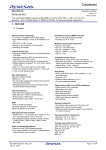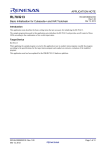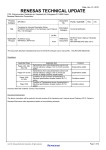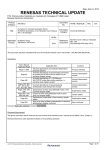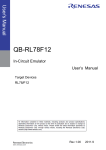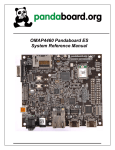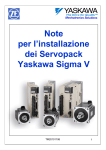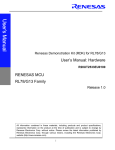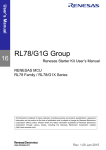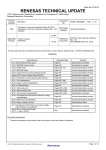Download R8C/36M Group and RL78/G13, RL78/G14 Function Comparison
Transcript
APPLICATION NOTE R8C/36M Group, RL78/G13, RL78/G14 Peripheral Function Comparison between R8C/36M Group and RL78/G13, RL78/G14 R01AN0838EJ0101 Rev. 1.01 Mar. 5, 2012 Abstract This document describes the Peripheral Function Comparison between R8C/36M Group and RL78/G13, RL78/G14. Products R8C Family: R8C/36M Group RL78 Family: RL/G13 (64-pin products), RL78/G14 (64-pin products) For more details and electrical characteristics, refer to the hardware user’s manual and technical updates. R01AN0838EJ0101 Rev. 1.01 Mar. 5, 2012 Page 1 of 15 R8C/36M Group, RL78/G13, RL78/G14 1. Peripheral Function Comparison between R8C/36M Group and RL78/G13, RL78/G14 Peripheral Function Comparison Table 1.1 to Table 1.11 show the peripheral function comparison between the R8C/36M Group and RL/G13 (64-pin products), RL78/G14 (64-pin products). In this application note, peripheral functions of the RL78/G14 and RL78/G13 are compared to the peripheral functions in the R8C/36M Group in order to show a guideline when the R8C Family is replaced with the RL78 Family. Tables comparing the peripheral functions show which peripheral functions of the RL78/G14 and RL78/G13 apply to the peripheral functions of the R8C/36M Group. A comparison of CPU cores is not included in the tables. CPU cores and clock circuitry are different between the R8C Family and RL78 Family. Note that peripheral functions inherited from the R8C Family (timer RJ (1), timer RD, timer RG, and DTC) may not be able to perform the same operations in the RL78 Family. For more details on RL78/G14 and RL78/G13 peripheral functions, refer to the documents listed in 2. Reference Documents. Note: 1. Timer RJ is a 16-bit version of timer RA (an 8-bit timer with an 8-bit prescaler). R01AN0838EJ0101 Rev. 1.01 Mar. 5, 2012 Page 2 of 15 R01AN0838EJ0101 Rev. 1.01 Mar. 5, 2012 Interrupts Protection Ports — (High current drive ports) N-ch open-drain can be selected by the port output mode registers Drive capacity control — Function of voltage detector (LVD) (Interrupt mode) Peripheral function interrupt External interrupt input (INTP0 to INTP11) (No input filter included Both edges, rising edge, and falling edge can be selected) Key interrupt input (KRM0 to KRM7) (Falling edge only) Peripheral function interrupts INT interrupt input (INT0 to INT4) (INT input filter included Both edges, rising edge, and falling edge can be selected) Key interrupt input (KI0 to KI3) (falling edge or rising edge set) INT interrupts Key input interrupts — Function of voltage detector (LVD) (Interrupt mode) — Voltage monitor 2 interrupt/comparator A2 interrupt Voltage monitor 1 interrupt — Voltage monitor 1 interrupt/comparator A1 interrupt Address match interrupt Internal reset by overflow of watchdog timer — Oscillation stop detection interrupt — INT instruction interrupt Watchdog timer interrupt — Execution interrupt of BRK instruction BRK interrupt Internal reset by execution of illegal instruction Overflow interrupt Undefined instruction interrupt Protect by protect register (protect rewriting registers Protect by invalid memory access detection control register (protect rewriting registers associated with part of associated with part of RAM, ports, interrupts, clocks, RAM, ports, interrupts, clocks, and voltage detection, etc.) and voltage detection, etc.) A TTL input buffer can be selected using the port input mode register. Input threshold control Voltage monitor 2 interrupt Maskable interrupts Non-maskable interrupts Protect function for rewriting registers Output port Input port Function of voltage detector (LVD) (Interrupt mode) Port mode register i (i = 0 to 7, 12 to 14) Input/output control Function of voltage detector (LVD) (Interrupt mode) Pull-up resistor option Voltage monitor 2 interrupt Voltage monitor 2 Pull-up control Voltage monitor 1 interrupt Voltage monitor 1 Port Pi direction register (i = 0 to 6, 8) Voltage monitor 0 reset Software reset Voltage monitor 0 — Watchdog timer reset • Function of voltage detector (LVD) (reset mode) • Function of voltage detector (LVD) (Interrupt and reset mode) Internal reset by comparison of supply voltage of the voltage detector (LVD) and detection voltage Internal reset by watchdog timer program loop detection Voltage monitor 0 reset Internal reset by comparison of supply voltage and detection voltage of power-on-reset (POR) circuit RL78/G13 (64-pin products) Power-on reset RL78/G14 (64-pin products) External reset input via RESET pin R8C/36M Group (64-pin products) Hardware reset Table 1.1 Voltage Detection Circuits Resets Item R8C/36M Group, RL78/G13, RL78/G14 Peripheral Function Comparison between R8C/36M Group and RL78/G13, RL78/G14 Peripheral Function Comparison (1) Page 3 of 15 R01AN0838EJ0101 Rev. 1.01 Mar. 5, 2012 Data Transfer DTC (data transfer Functions controller) Watchdog timers Interval interrupt when 75% of the overflow time is reached Internal reset by watchdog timer program loop detection • Overflow • Write during a window close period • Use a 1-bit manipulation instruction on the WDTE register • Write data other than “ACH” to the WDTE register DTC (normal mode, repeat mode, chain transfers) Unit of transfers (8 bits/16 bits) HALT/SNOOZE: Normal operation, STOP mode: Operation stopped Control data allocation variable Watchdog timer interrupt • Underflow • Writing during out of the refresh acknowledgement period for the watchdog timer Watchdog timer reset • Underflow • Writing during out of the refresh acknowledgement period for the watchdog timer DTC (normal mode, repeat mode, and chain transfers) Unit of transfers (8 bits) Operation cannot be performed in wait or stop mode Fix control data allocation — HALT: Normal operation, STOP and SNOOZE mode: Operation stopped DMA (single transfer) Always protect count source • The count source is the internal low-speed oscillation clock Count source protection mode can be selected • Disabled: The count source for the watchdog timer is the CPU clock • Enabled: The count source for the watchdog timer is the low-speed on-chip oscillator clock for the watchdog timer RL78/G13 (64-pin products) • Select watchdog timer start at reset • Select count source protection mode after reset • Set watchdog timer underflow period • Set watchdog timer refresh acknowledgement period • Select voltage detection 0 circuit start • Select voltage detection 0 level • Select ROM code protect function RL78/G14 (64-pin products) • Select watchdog timer operation • Select watchdog timer operation in HALT/STOP mode • Set watchdog timer overflow time • Set window open period of watchdog timer • Select watchdog timer interval interrupt • Set LVD operation mode • Set LVD detection level (VLVIH) • Set minimum operation voltage (VLVIL) • Set frequency of the internal high-speed oscillator • Set flash operation mode • Handling of data of flash memory in case of failure in on-chip debug security ID authentication • Select control of on-chip debug operation R8C/36M Group (64-pin products) Table 1.2 Option function select areas Item R8C/36M Group, RL78/G13, RL78/G14 Peripheral Function Comparison between R8C/36M Group and RL78/G13, RL78/G14 Peripheral Function Comparison (2) Page 4 of 15 Timers R01AN0838EJ0101 Rev. 1.01 Mar. 5, 2012 • TAU interval timer • Interval timer • TAU square wave output • TAU divider function (channel 0 (unit 0 only)) TAU external event counter TAU measurement of high-/low-level width of input signal TAU input pulse interval measurement • Timer RJ (pulse output mode) • Timer RD (timer mode (output compare function)) • Timer RG (timer mode (output compare function)) • TAU square wave output • TAU divider function (channel 0 (unit 0 only)) • Timer RJ (event counter mode) • Timer RD (timer mode) • Timer RG (timer mode) • TAU external event counter • Timer RJ (pulse width measurement mode) • Timer RD (timer mode (input capture function)) • Timer RG (timer mode (input capture function)) • TAU measurement of high-/low-level width of input signal • Timer RJ (pulse period measurement mode) • Timer RD (timer mode (input capture function)) • Timer RG (timer mode (input capture function)) • TAU input pulse interval measurement Timer RA (pulse output mode) Timer RA (pulse width measurement mode) Timer RA (pulse period measurement mode) RL78/G13 (64-pin products) Timer RA (timer mode) RL78/G14 (64-pin products) • Timer RJ (timer mode) • Timer RD (timer mode) • Timer RG (timer mode) • TAU interval timer • Interval timer R8C/36M Group (64-pin products) Table 1.3 Timer RA (8-bit timer with 8-bit prescaler) Timer RA (event counter mode) Item R8C/36M Group, RL78/G13, RL78/G14 Peripheral Function Comparison between R8C/36M Group and RL78/G13, RL78/G14 Peripheral Function Comparison (3) Page 5 of 15 R01AN0838EJ0101 Rev. 1.01 Mar. 5, 2012 Timers •TAU square wave output •TAU divider function (channel 0 (unit 0 only)) •TAU PWM output (channels 0-1 to 7, 2-3 to 7, 4-5 to 7, and 6-7) TAU one-shot pulse output (channels 0-1 to 7, 2-3 to 7, 4-5 to 7, and 6-7) TAU one-shot pulse output (channels 0-1 to 7, 2-3 to 7, 4-5 to 7, and 6-7) • Timer RD (PWM mode) Timer RB (programmable one-shot generation mode) • TAU one-shot pulse output (channels 0-1 to 3 and 2-3) • Timer RD (PWM mode) • TAU one-shot pulse output (channels 0-1 to 3 and 2-3) Timer RB (timer mode) • Timer RJ (pulse output mode) • Timer RD (timer mode (output compare function) and PWM mode) • Timer RG (timer mode (output compare function) and PWM mode) • TAU square wave output • TAU divider function (channel 0 (unit 0 only)) • TAU PWM output (channels 0-1 to 3 and 2-3) RL78/G13 (64-pin products) • TAU interval timer • Interval timer RL78/G14 (64-pin products) • Timer RJ (timer mode) • Timer RD (timer mode) • Timer RG (timer mode) • TAU interval timer • Interval timer R8C/36M Group (64-pin products) Timer RB (programmable wait one-shot generation mode) Table 1.4 Timer RB (programmable waveform generation Timer RB (8-bit timer with mode) 8-bit prescaler) Item R8C/36M Group, RL78/G13, RL78/G14 Peripheral Function Comparison between R8C/36M Group and RL78/G13, RL78/G14 Peripheral Function Comparison (4) Page 6 of 15 Timers • TAU interval timer • Interval timer • TAU external event counter • TAU input pulse interval measurement • TAU measurement of high-/low-level width of input signal • TAU square wave output • TAU divider function (channel 0 (unit 0 only)) • TAU PWM output (channels 0-1 to 7, 2-3 to 7, 4-5 to 7, and 6-7) TAU PWM output (channels 0-1 to 7, 2-3 to 7, 4-5 to 7, and 6-7) • TAU PWM output (channels 0-1 to 7, 2-3 to 7, 4-5 to 7, and 6-7) • TAU one-shot pulse output (channels 0-1 to 7, 2-3 to 7, 4-5 to 7, and 6-7) • Timer RJ (pulse width measurement mode and pulse period measurement mode) • Timer RD (timer mode (input capture function)) • Timer RG (timer mode (input capture function)) • TAU input pulse interval measurement • TAU measurement of high-/low-level width of input signal • Timer RJ (pulse output mode) • Timer RD (timer mode (output compare function) and PWM mode) • Timer RG (timer mode (output compare function) and PWM mode) • TAU square wave output • TAU divider function (channel 0 (unit 0 only)) • TAU PWM output (channels 0-1 to 3 and 2-3) • Timer RD (PWM mode) • Timer RG (PWM mode) • TAU PWM output (channels 0-1 to 3 and 2-3) • Timer RD (timer mode (output compare function) and PWM mode) • Timer RG (timer mode (output compare function) and PWM mode) • TAU PWM output (channels 0-1 to 3 and 2-3) • TAU one-shot pulse output (channels 0-1 to 3 and 2-3) Timer RC (timer mode (input capture function)) Timer RC (timer mode (output compare function)) Timer RC (PWM mode) Timer RC (PWM2 mode) RL78/G13 (64-pin products) Timer RC (timer mode) RL78/G14 (64-pin products) • Timer RJ (timer mode and event counter mode) • Timer RD (timer mode) • Timer RG (timer mode) • TAU interval timer • Interval timer • TAU external event counter R8C/36M Group (64-pin products) Table 1.5 R01AN0838EJ0101 Rev. 1.01 Mar. 5, 2012 Timer RC (16-bit timer) Item R8C/36M Group, RL78/G13, RL78/G14 Peripheral Function Comparison between R8C/36M Group and RL78/G13, RL78/G14 Peripheral Function Comparison (5) Page 7 of 15 Timers R01AN0838EJ0101 Rev. 1.01 Mar. 5, 2012 • TAU input pulse interval measurement • TAU measurement of high-/low-level width of input signal • TAU square wave output • TAU divider function (channel 0 (unit 0 only)) • TAU PWM output (channels 0-1 to 7, 2-3 to 7, 4-5 to 7, and 6-7) TAU PWM output (channels 0-1 to 7, 2-3 to 7, 4-5 to 7, and 6-7) TAU multiple PWM output (channels 0-1-2, 0-2-3, 0-3-4, 0-4-5, 0-5-6, 0-6-7, 2-3-4, 2-4-5, 2-5-6, 2-6-7, 4-5-6, and 4-6-7) • Timer RJ (pulse width measurement mode and pulse period measurement mode) • Timer RD (timer mode (input capture function)) • Timer RG (timer mode (input capture function)) • TAU input pulse interval measurement • TAU measurement of high-/low-level width of input signal • Timer RJ (pulse output mode) • Timer RD (timer mode (output compare function) and PWM mode) • Timer RG (timer mode (output compare function) and PWM mode) • TAU square wave output • TAU divider function (channel 0 (unit 0 only)) • TAU PWM output (channels 0-1 to 3 and 2-3) • Timer RD (PWM mode) • Timer RG (PWM mode) • TAU PWM output (channels 0-1 to 3 and 2-3) • Timer RD (reset synchronous PWM mode) • TAU multiple PWM output (channels 0-1-2 and 0-2-3) • Timer RD (complementary PWM mode) • Timer RD (PWM3 mode) Timer RD (timer mode (input capture function)) Timer RD (timer mode (output compare function)) Timer RD (PWM mode) Timer RD (reset synchronous PWM mode) Timer RD (complementary PWM mode) Timer RD (PWM3 mode) — — • TAU interval timer • Interval timer • TAU external event counter RL78/G13 (64-pin products) Timer RD (timer mode) RL78/G14 (64-pin products) • Timer RJ (timer mode and event counter mode) • Timer RD (timer mode) • Timer RG (timer mode) • TAU interval timer • Interval timer • TAU external event counter R8C/36M Group (64-pin products) Table 1.6 Timer RD (16-bit timer) Item R8C/36M Group, RL78/G13, RL78/G14 Peripheral Function Comparison between R8C/36M Group and RL78/G13, RL78/G14 Peripheral Function Comparison (6) Page 8 of 15 R01AN0838EJ0101 Rev. 1.01 Mar. 5, 2012 Timers Timer RF (16-bit timer) R8C/36M Group (64-pin products) RL78/G14 (64-pin products) • TAU input pulse interval measurement • TAU measurement of high-/low-level width of input signal • TAU square wave output • TAU divider function (channel 0 (unit 0 only)) • TAU PWM output (channels 0-1 to 7, 2-3 to 7, 4-5 to 7, and 6-7) • TAU multiple PWM output (channels 0-1-2, 0-2-3, 0-3-4, 0-4-5, 0-5-6, 0-6-7, 2-3-4, 2-4-5, 2-5-6, 2-6-7, 4-5-6, and 4-6-7) • Timer RJ (pulse width measurement mode and pulse period measurement mode) • Timer RD (timer mode (input capture function)) • Timer RG (timer mode (input capture function)) • TAU input pulse interval measurement • TAU measurement of high-/low-level width of input signal • Timer RJ (pulse output mode) • Timer RD (timer mode (output compare function), PWM mode, and PWM3 mode) • Timer RG (timer mode (output compare function) and PWM mode) • TAU square wave output • TAU divider function (channel 0 (unit 0 only)) • TAU PWM output (channels 0-1 to 3 and 2-3) • TAU multiple PWM output (channels 0-1-2 and 0-2-3) Timer RF (input capture mode) Timer RF (output compare mode) • TAU square wave output • TAU divider function (channel 0 (unit 0 only)) • TAU PWM output (channels 0-1 to 7, 2-3 to 7, 4-5 to 7, and 6-7) RL78/G13 (64-pin products) Timer RE (output compare mode) Real-time clock • Timer RJ (pulse output mode) • Timer RD (timer mode (output compare function) and PWM mode) • Timer RG (timer mode (output compare function) and PWM mode) • TAU square wave output • TAU divider function (channel 0 (unit 0 only)) • TAU PWM output (channels 0-1 to 3 and 2-3) Timer RE (real-time clock mode) Table 1.7 Timer RE (4-bit counter and 8-bit counter) Item R8C/36M Group, RL78/G13, RL78/G14 Peripheral Function Comparison between R8C/36M Group and RL78/G13, RL78/G14 Peripheral Function Comparison (7) Page 9 of 15 Timers R01AN0838EJ0101 Rev. 1.01 Mar. 5, 2012 — Clock output/buzzer output TAU external event counter Clock output/buzzer output controller (PCLBUZ0 and 1) TAU delay counter • Timer RG (phase counting mode) • TAU external event counter Timer RG (phase counting mode) — TAU PWM output (channels 0-1 to 7, 2-3 to 7, 4-5 to 7, and 6-7) • Timer RD (PWM mode) • Timer RG (PWM mode) • TAU PWM output (channels 0-1 to 3 and 2-3) Timer RG (PWM mode) Delay counter • TAU square wave output • TAU divider function (channel 0 (unit 0 only)) • TAU PWM output (channels 0-1 to 7, 2-3 to 7, 4-5 to 7, and 6-7) Timer RG (timer mode (input capture function)) Timer RG (timer mode (output compare function)) • TAU input pulse interval measurement • TAU measurement of high-/low-level width of input signal • Timer RJ (pulse width measurement mode and pulse period measurement mode) • Timer RD (timer mode (input capture function)) • Timer RG (timer mode (input capture function)) • TAU input pulse interval measurement • TAU measurement of high-/low-level width of input signal • Timer RJ (pulse output mode) • Timer RD (timer mode (output compare function) and PWM mode) • Timer RG (timer mode (output compare function) and PWM mode) • TAU square wave output • TAU divider function (channel 0 (unit 0 only)) • TAU PWM output (channels 0-1 to 3 and 2-3) • TAU interval timer • Interval timer • TAU external event counter RL78/G13 (64-pin products) Timer RG (timer mode) RL78/G14 (64-pin products) • Timer RJ (timer mode and event counter mode) • Timer RD (timer mode) • Timer RG (timer mode) • TAU interval timer • Interval timer • TAU external event counter R8C/36M Group (64-pin products) Table 1.8 Timer RG (16-bit timer) Item R8C/36M Group, RL78/G13, RL78/G14 Peripheral Function Comparison between R8C/36M Group and RL78/G13, RL78/G14 Peripheral Function Comparison (8) Page 10 of 15 R01AN0838EJ0101 Rev. 1.01 Mar. 5, 2012 Communications Serial Interface UART1 Serial array unit UART UART0 [CSI00 (unit 0 channel 0) and CSI01 (unit 0 channel 1)] UART1 [CSI10 (unit 0 channel 2) and CSI11 (unit 0 channel 3)] UART2 [CSI20 (unit 1 channel 0) and CSI21 (unit 1 channel 1)] Serial array unit: 3-Wire Serial I/O Communication CSI00 (unit 0 channel 0) CSI01 (unit 0 channel 1) CSI10 (unit 0 channel 2) CSI11 (unit 0 channel 3) CSI20 (unit 1 channel 0) CSI21 (unit 1 channel 1) Serial array unit UART UART0 [CSI00 (unit 0 channel 0) and CSI01 (unit 0 channel 1)] UART1 [CSI10 (unit 0 channel 2) and CSI11 (unit 0 channel 3)] UART2 [CSI20 (unit 1 channel 0) and CSI21 (unit 1 channel 1)] Clock Synchronous Serial I/O Mode Clock Asynchronous Serial I/O (UART) Mode Clock Synchronous Serial I/O Mode Clock Asynchronous Serial I/O (UART) Mode RL78/G14 (64-pin products) Serial array unit: 3-Wire Serial I/O Communication CSI00 (unit 0 channel 0) CSI01 (unit 0 channel 1) CSI10 (unit 0 channel 2) CSI11 (unit 0 channel 3) CSI20 (unit 1 channel 0) CSI21 (unit 1 channel 1) R8C/36M Group (64-pin products) RL78/G13 (64-pin products) Table 1.9 Serial Interface UART0 Item R8C/36M Group, RL78/G13, RL78/G14 Peripheral Function Comparison between R8C/36M Group and RL78/G13, RL78/G14 Peripheral Function Comparison (9) Page 11 of 15 R01AN0838EJ0101 Rev. 1.01 Mar. 5, 2012 Note: 1. Hardware LIN I2C bus interface (1) Synchronous serial communication unit (SSU) (1) Serial array unit UART Serial array unit UART UART0 (unit 0 channels 0 and 1) supporting LIN-bus UART2 (unit 1 channels 0 and 1) supporting LIN-bus LIN communication in cooperation with timer RA and UART0 I2C bus Interface mode Clock synchronous serial mode — Serial interface IICA 4-wire bus communication mode: bidirectional mode Serial array unit 3-wire serial I/O CSI00 (unit 0 channel 0) CSI01 (unit 0 channel 1) CSI02 (unit 0 channel 2) CSI10 (unit 1 channel 0) CSI11 (unit 1 channel 1) Serial array unit : SPI function communication CSI00 (unit 0 channel 0) — (Arbitration not checked and chip select controlled by ports) 4-wire bus communication mode: standard mode Multiprocessor communication function Clock synchronous communication mode — Special mode 1 (I2C mode) (Master/slave function in single master system) Clock synchronous serial interface (SSU and I2C bus interface cannot be used at the same time for R8C.) Communications Serial array unit : Simplified I2C Communication (only master function in single master system) IIC00 (unit 0 channel 0) IIC01 (unit 0 channel 1) IIC10 (unit 0 channel 2) IIC11 (unit 0 channel 3) IIC20 (unit 1 channel 0) IIC21 (unit 1 channel 1) Serial array unit : 3-wire serial I/O CSI00 (unit 0 channel 0) CSI01 (unit 0 channel 1) CSI02 (unit 0 channel 2) CSI10 (unit 1 channel 0) CSI11 (unit 1 channel 1) Serial array unit UART UART0 [CSI00 (unit 0 channel 0) and CSI01 (unit 0 channel 1)] UART1 [CSI10 (unit 0 channel 2) and CSI11 (unit 0 channel 3)] UART2 [CSI20 (unit 1 channel 0) and CSI21 (unit 1 channel 1)] Clock Asynchronous Serial I/O (UART) Mode RL78/G13 (64-pin products) Clock Synchronous Serial I/O Mode RL78/G14 (64-pin products) Serial array unit : 3-Wire Serial I/O CSI00 (unit 0 channel 0) CSI01 (unit 0 channel 1) CSI10 (unit 0 channel 2) CSI11 (unit 0 channel 3) CSI20 (unit 1 channel 0) CSI21 (unit 1 channel 1) R8C/36M Group (64-pin products) Table 1.10 Serial Interface UART2 Item R8C/36M Group, RL78/G13, RL78/G14 Peripheral Function Comparison between R8C/36M Group and RL78/G13, RL78/G14 Peripheral Function Comparison (10) Page 12 of 15 R01AN0838EJ0101 Rev. 1.01 Mar. 5, 2012 Clocks Flash Memories — HALT mode High-speed on-chip oscillator (40MHz [divide-by-2 to 9 can be selected]) Low-speed on-chip oscillator (125 kHz) Wait mode On-chip oscillation circuit (high speed) On-chip oscillation circuit (low speed) XT1 oscillator (32.768 kHz) RL78/G13 (64-pin products) SNOOZE mode — • Timer array unit • Timer RJ • Timer RD • Timer RG • Real-time clock • Interval timer • A/D converter • D/A converter • Comparator • Serial array unit • Serial interface IICA • DTC STOP mode • Timer array unit • Real-time clock • Interval timer • A/D converter • Serial array unit • Serial interface IICA Internal high-speed oscillator Internal high-speed oscillator (64 MHz, 48 MHz, 32 MHz, 24 MHz, 16 MHz, 12 MHz, (32 MHz, 24 MHz, 16 MHz, 12 MHz, 8 MHz, or 1MHz 8 MHz, or 1MHz can be selected) can be selected) Stop mode • Timer RC • Timer RD Enable/disable peripheral • Timer RG clock provision • SSU, I2C bus • A/D converter Power control Internal low-speed oscillator (15kHz) XCIN clock generation circuit (32.768 kHz) X1 oscillator (1 to 20 MHz) XIN clock generation circuit (0 to 20 MHz) External sub-oscillator • Disabling block erase • Disabling write • Disabling rewriting boot cluster 0 • Flash shield window function (self-programming only) • On-chip debug security ID Flash memory programming by self-programming External oscillator CPU rewrite mode Software programming Flash memory programming mode UART0 Security function Parallel I/O mode Parallel I/F programming RL78/G14 (64-pin products) Flash memory programming mode single-line UART • ID code check function (standard serial I/O mode) • ROM code protect function (parallel I/O mode) • Data protect function (CPU rewrite mode) Standard serial I/O mode 2 UART programming R8C/36M Group (64-pin products) Standard serial I/O mode 3 Item Table 1.11 1-wire programming R8C/36M Group, RL78/G13, RL78/G14 Peripheral Function Comparison between R8C/36M Group and RL78/G13, RL78/G14 Peripheral Function Comparison (11) Page 13 of 15 R01AN0838EJ0101 Rev. 1.01 Mar. 5, 2012 Analog Converter Functions Comparator 0, comparator 1 (only for products with a code flash memory size of 96 — KB or more) Comparator 0, comparator 1 (only for products with a code flash memory size of 96 — KB or more) • Compare a reference input voltage and an analog input voltage. • Output compared results Compare a reference input voltage and an analog input voltage. Comparator A Comparator B — D/A converter (only for products with a code flash memory size of 96 KB or more) D/A converter Scan mode, One-shot conversion mode Scan mode, Sequential conversion mode Repeat sweep mode D/A converter — Single sweep mode Select mode, sequential conversion mode Repeat mode 1 Repeat mode 0 RL78/G14 (64-pin products) Select mode, one-shot conversion mode R8C/36M Group (64-pin products) One-shot mode RL78/G13 (64-pin products) Table 1.12 A/D converter Item R8C/36M Group, RL78/G13, RL78/G14 Peripheral Function Comparison between R8C/36M Group and RL78/G13, RL78/G14 Peripheral Function Comparison (12) Page 14 of 15 R8C/36M Group, RL78/G13, RL78/G14 2. Peripheral Function Comparison between R8C/36M Group and RL78/G13, RL78/G14 Reference Documents R36M Group User’s Manual: Hardware Rev.1.00 RL78/G13 User’s Manual: Hardware Rev.0.03 RL78/G14 User’s Manual: Hardware Rev.0.02 The latest version can be downloaded from the Renesas Electronics website. Technical Update/Technical News The latest information can be downloaded from the Renesas Electronics website. Website and Support Renesas Electronics website http://www.renesas.com Inquiries http://www.renesas.com/contact/ R01AN0838EJ0101 Rev. 1.01 Mar. 5, 2012 Page 15 of 15 Revision History Rev. Date 1.00 Oct. 4, 2011 1.01 Mar. 5, 2012 R8C/36M Group, RL78/G13, RL78/G14 Peripheral Function Comparison between R8C/36M Group and RL78/G13, RL78/G14 Description Page Summary — First edition issued — Descriptions of Table 1.3 to 1.8 adjusted 13 Table 1.11 Item in clocks added All trademarks and registered trademarks are the property of their respective owners. A-1 General Precautions in the Handling of MPU/MCU Products The following usage notes are applicable to all MPU/MCU products from Renesas. For detailed usage notes on the products covered by this manual, refer to the relevant sections of the manual. If the descriptions under General Precautions in the Handling of MPU/MCU Products and in the body of the manual differ from each other, the description in the body of the manual takes precedence. 1. Handling of Unused Pins Handle unused pins in accord with the directions given under Handling of Unused Pins in the manual. The input pins of CMOS products are generally in the high-impedance state. In operation with an unused pin in the open-circuit state, extra electromagnetic noise is induced in the vicinity of LSI, an associated shoot-through current flows internally, and malfunctions occur due to the false recognition of the pin state as an input signal become possible. Unused pins should be handled as described under Handling of Unused Pins in the manual. 2. Processing at Power-on The state of the product is undefined at the moment when power is supplied. The states of internal circuits in the LSI are indeterminate and the states of register settings and pins are undefined at the moment when power is supplied. In a finished product where the reset signal is applied to the external reset pin, the states of pins are not guaranteed from the moment when power is supplied until the reset process is completed. In a similar way, the states of pins in a product that is reset by an on-chip power-on reset function are not guaranteed from the moment when power is supplied until the power reaches the level at which resetting has been specified. 3. Prohibition of Access to Reserved Addresses Access to reserved addresses is prohibited. The reserved addresses are provided for the possible future expansion of functions. Do not access these addresses; the correct operation of LSI is not guaranteed if they are accessed. 4. Clock Signals After applying a reset, only release the reset line after the operating clock signal has become stable. When switching the clock signal during program execution, wait until the target clock signal has stabilized. When the clock signal is generated with an external resonator (or from an external oscillator) during a reset, ensure that the reset line is only released after full stabilization of the clock signal. Moreover, when switching to a clock signal produced with an external resonator (or by an external oscillator) while program execution is in progress, wait until the target clock signal is stable. 5. Differences between Products Before changing from one product to another, i.e. to one with a different part number, confirm that the change will not lead to problems. The characteristics of MPU/MCU in the same group but having different part numbers may differ because of the differences in internal memory capacity and layout pattern. When changing to products of different part numbers, implement a system-evaluation test for each of the products. Notice 1. All information included in this document is current as of the date this document is issued. Such information, however, is subject to change without any prior notice. Before purchasing or using any Renesas Electronics products listed herein, please confirm the latest product information with a Renesas Electronics sales office. Also, please pay regular and careful attention to additional and different information to be disclosed by Renesas Electronics such as that disclosed through our website. 2. Renesas Electronics does not assume any liability for infringement of patents, copyrights, or other intellectual property rights of third parties by or arising from the use of Renesas Electronics products or technical information described in this document. No license, express, implied or otherwise, is granted hereby under any patents, copyrights or other intellectual property rights of Renesas Electronics or others. 3. You should not alter, modify, copy, or otherwise misappropriate any Renesas Electronics product, whether in whole or in part. 4. Descriptions of circuits, software and other related information in this document are provided only to illustrate the operation of semiconductor products and application examples. You are fully responsible for the incorporation of these circuits, software, and information in the design of your equipment. Renesas Electronics assumes no responsibility for any losses incurred by you or third parties arising from the use of these circuits, software, or information. 5. When exporting the products or technology described in this document, you should comply with the applicable export control laws and regulations and follow the procedures required by such laws and regulations. You should not use Renesas Electronics products or the technology described in this document for any purpose relating to military applications or use by the military, including but not limited to the development of weapons of mass destruction. Renesas Electronics products and technology may not be used for or incorporated into any products or systems whose manufacture, use, or sale is prohibited under any applicable domestic or foreign laws or regulations. 6. Renesas Electronics has used reasonable care in preparing the information included in this document, but Renesas Electronics does not warrant that such information is error free. Renesas Electronics 7. Renesas Electronics products are classified according to the following three quality grades: "Standard", "High Quality", and "Specific". The recommended applications for each Renesas Electronics product assumes no liability whatsoever for any damages incurred by you resulting from errors in or omissions from the information included herein. depends on the product's quality grade, as indicated below. You must check the quality grade of each Renesas Electronics product before using it in a particular application. You may not use any Renesas Electronics product for any application categorized as "Specific" without the prior written consent of Renesas Electronics. Further, you may not use any Renesas Electronics product for any application for which it is not intended without the prior written consent of Renesas Electronics. Renesas Electronics shall not be in any way liable for any damages or losses incurred by you or third parties arising from the use of any Renesas Electronics product for an application categorized as "Specific" or for which the product is not intended where you have failed to obtain the prior written consent of Renesas Electronics. The quality grade of each Renesas Electronics product is "Standard" unless otherwise expressly specified in a Renesas Electronics data sheets or data books, etc. "Standard": Computers; office equipment; communications equipment; test and measurement equipment; audio and visual equipment; home electronic appliances; machine tools; personal electronic equipment; and industrial robots. "High Quality": Transportation equipment (automobiles, trains, ships, etc.); traffic control systems; anti-disaster systems; anti-crime systems; safety equipment; and medical equipment not specifically designed for life support. "Specific": Aircraft; aerospace equipment; submersible repeaters; nuclear reactor control systems; medical equipment or systems for life support (e.g. artificial life support devices or systems), surgical implantations, or healthcare intervention (e.g. excision, etc.), and any other applications or purposes that pose a direct threat to human life. 8. You should use the Renesas Electronics products described in this document within the range specified by Renesas Electronics, especially with respect to the maximum rating, operating supply voltage range, movement power voltage range, heat radiation characteristics, installation and other product characteristics. Renesas Electronics shall have no liability for malfunctions or damages arising out of the use of Renesas Electronics products beyond such specified ranges. 9. Although Renesas Electronics endeavors to improve the quality and reliability of its products, semiconductor products have specific characteristics such as the occurrence of failure at a certain rate and malfunctions under certain use conditions. Further, Renesas Electronics products are not subject to radiation resistance design. Please be sure to implement safety measures to guard them against the possibility of physical injury, and injury or damage caused by fire in the event of the failure of a Renesas Electronics product, such as safety design for hardware and software including but not limited to redundancy, fire control and malfunction prevention, appropriate treatment for aging degradation or any other appropriate measures. Because the evaluation of microcomputer software alone is very difficult, please evaluate the safety of the final products or system manufactured by you. 10. Please contact a Renesas Electronics sales office for details as to environmental matters such as the environmental compatibility of each Renesas Electronics product. Please use Renesas Electronics products in compliance with all applicable laws and regulations that regulate the inclusion or use of controlled substances, including without limitation, the EU RoHS Directive. Renesas Electronics assumes no liability for damages or losses occurring as a result of your noncompliance with applicable laws and regulations. 11. This document may not be reproduced or duplicated, in any form, in whole or in part, without prior written consent of Renesas Electronics. 12. Please contact a Renesas Electronics sales office if you have any questions regarding the information contained in this document or Renesas Electronics products, or if you have any other inquiries. (Note 1) "Renesas Electronics" as used in this document means Renesas Electronics Corporation and also includes its majority-owned subsidiaries. (Note 2) "Renesas Electronics product(s)" means any product developed or manufactured by or for Renesas Electronics. http://www.renesas.com SALES OFFICES Refer to "http://www.renesas.com/" for the latest and detailed information. Renesas Electronics America Inc. 2880 Scott Boulevard Santa Clara, CA 95050-2554, U.S.A. Tel: +1-408-588-6000, Fax: +1-408-588-6130 Renesas Electronics Canada Limited 1101 Nicholson Road, Newmarket, Ontario L3Y 9C3, Canada Tel: +1-905-898-5441, Fax: +1-905-898-3220 Renesas Electronics Europe Limited Dukes Meadow, Millboard Road, Bourne End, Buckinghamshire, SL8 5FH, U.K Tel: +44-1628-585-100, Fax: +44-1628-585-900 Renesas Electronics Europe GmbH Arcadiastrasse 10, 40472 Düsseldorf, Germany Tel: +49-211-65030, Fax: +49-211-6503-1327 Renesas Electronics (China) Co., Ltd. 7th Floor, Quantum Plaza, No.27 ZhiChunLu Haidian District, Beijing 100083, P.R.China Tel: +86-10-8235-1155, Fax: +86-10-8235-7679 Renesas Electronics (Shanghai) Co., Ltd. Unit 204, 205, AZIA Center, No.1233 Lujiazui Ring Rd., Pudong District, Shanghai 200120, China Tel: +86-21-5877-1818, Fax: +86-21-6887-7858 / -7898 Renesas Electronics Hong Kong Limited Unit 1601-1613, 16/F., Tower 2, Grand Century Place, 193 Prince Edward Road West, Mongkok, Kowloon, Hong Kong Tel: +852-2886-9318, Fax: +852 2886-9022/9044 Renesas Electronics Taiwan Co., Ltd. 13F, No. 363, Fu Shing North Road, Taipei, Taiwan Tel: +886-2-8175-9600, Fax: +886 2-8175-9670 Renesas Electronics Singapore Pte. Ltd. 1 harbourFront Avenue, #06-10, keppel Bay Tower, Singapore 098632 Tel: +65-6213-0200, Fax: +65-6278-8001 Renesas Electronics Malaysia Sdn.Bhd. Unit 906, Block B, Menara Amcorp, Amcorp Trade Centre, No. 18, Jln Persiaran Barat, 46050 Petaling Jaya, Selangor Darul Ehsan, Malaysia Tel: +60-3-7955-9390, Fax: +60-3-7955-9510 Renesas Electronics Korea Co., Ltd. 11F., Samik Lavied' or Bldg., 720-2 Yeoksam-Dong, Kangnam-Ku, Seoul 135-080, Korea Tel: +82-2-558-3737, Fax: +82-2-558-5141 © 2012 Renesas Electronics Corporation. All rights reserved. Colophon 1.1


















